
Cyanoacrylates are a family of strong fast-acting adhesives with industrial, medical, and household uses. They are derived from ethyl cyanoacrylate and related esters. The cyanoacrylate group in the monomer rapidly polymerizes in the presence of water to form long, strong chains.
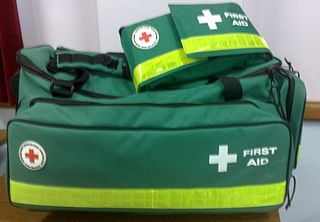
A first aid kit or medical kit is a collection of supplies and equipment used to give immediate medical treatment, primarily to treat injuries and other mild or moderate medical conditions. There is a wide variation in the contents of first aid kits based on the knowledge and experience of those putting it together, the differing first aid requirements of the area where it may be used, and variations in legislation or regulation in a given area.
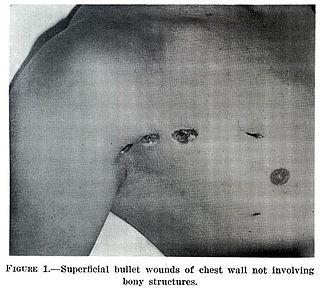
A wound is a rapid onset of injury that involves lacerated or punctured skin, or a contusion from blunt force trauma or compression. In pathology, a wound is an acute injury that damages the epidermis of the skin. To heal a wound, the body undertakes a series of actions collectively known as the wound healing process.

An adhesive bandage, also called a sticking plaster, medical plaster, or simply plaster in British English, is a small medical dressing used for injuries not serious enough to require a full-size bandage. They are also known by the genericized trademarks of Band-Aid or Elastoplast.

Pasties are patches that cover a person's nipples and areolae, typically self-adhesive or affixed with adhesive. They originated as part of burlesque shows, allowing dancers to perform fully topless without exposing the nipples in order to provide a commercial form of bare-breasted entertainment. Pasties are also, at times, used while sunbathing, worn by strippers and showgirls, or as a form of protest during women's rights events such as Go Topless Day. In some cases this is to avoid potential prosecution under indecency laws.
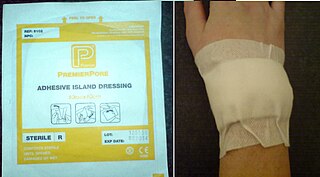
A dressing or compress is a sterile pad applied to a wound to promote healing and protect the wound from further harm. A dressing is designed to be in direct contact with the wound, as distinguished from a bandage, which is most often used to hold a dressing in place. Many modern dressings are self-adhesive.
Setting the features is a mortuary term for the closing of the eyes and the mouth of a deceased person such that the cadaver is presentable as being in a state of rest and repose, and thus more suitable for viewing. While it is one of the first stages of embalming, it is also commonly done as a token of respect even when the deceased is not viewed or is directly cremated. Generally only when the deceased have specifically requested the body be untouched are the features left unset.
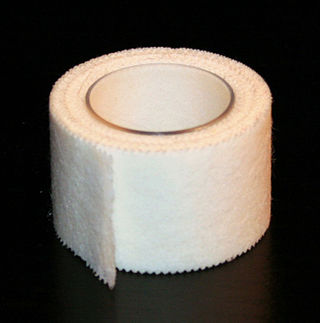
Surgical tape or medical tape is a type of pressure-sensitive adhesive tape used in medicine and first aid to hold a bandage or other dressing onto a wound. These tapes usually have a hypoallergenic adhesive which is designed to hold firmly onto skin, dressing materials, and underlying layers of tape, but to remove easily without damaging the skin. They allow air to reach the skin ("breathable"). Some breathable tapes such as kinesiology tape, and other elastic bandages with adhesive are made of cotton. Surgical tape is often white because it contains zinc oxide, which is added to help prevent infections. Tapes made of porous material, such as 3M Micropore, are widely used.
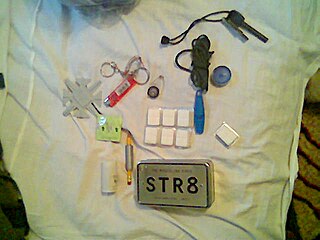
A mini survival kit contains essential outdoor survival tools and supplies. It is intended to be carried on one's person at all times, be appropriate to all environments, and be a comprehensive kit without being too large. Mini survival kits are intended to provide the basic needs of a survival situation, self-rescue, assistance or a return to normalcy in optimum situations.
Tincture of benzoin is a pungent solution of benzoin resin in ethanol. Benzoin is not a constituent of benzoin resin, the primary active ingredient of this natural product is actually benzoic acid. A similar preparation called Friar's Balsam or Compound Benzoin Tincture contains, in addition, Cape aloes or Barbados aloes and storax resin. Friar's balsam was invented by the English doctor and MP Joshua Ward c. 1760.
A barbed suture is a type of knotless surgical suture that has barbs on its surface. While suturing tissue, these barbs penetrate inside the tissue and lock them into place, eliminating the need for knots to tie the suture. Conventional sutures rely on a surgeon's ability to tie secure knots; barbed sutures provide a knotless alternative in some surgical situations. Barbed sutures are primarily used in cosmetic surgery.
Liquid bandage is a topical skin treatment for minor wounds which binds to the skin to form a protective polymeric layer that keeps dirt and germs out and moisture in.
An Emergency Care Practitioner (ECP) generally come from a background in paramedicine and most have additional academic qualifications, usually at university, with enhanced skills in medical assessment and extra clinical skills over and above those of a standard paramedic or qualified nurse. It has been recommended by the College of Paramedics that ECPs be trained to PgDip or MSc level, although not all are. Evidence of the best way to target Emergency Care Practitioners is limited with utilisation of traditional Ambulance dispatch codes not always being shown to be most effective and referrals from GPs also potentially failing to deliver management of demand that would be appropriate for this different level of practitioner. Evidence however clearly demonstrates that in discreet groups of patients the use of these extended role staff responding to emergency calls can reduce admissions and thus improve patient outcomes as well as delivering a clear cost saving to the NHS.
A dermal adhesive is a glue used to close wounds in the skin, as an alternative to sutures, staples or clips.

A surgical suture, also known as a stitch or stitches, is a medical device used to hold body tissues together and approximate wound edges after an injury or surgery. Application generally involves using a needle with an attached length of thread. There are numerous types of suture which differ by needle shape and size as well as thread material and characteristics. Selection of surgical suture should be determined by the characteristics and location of the wound or the specific body tissues being approximated.

n-Butyl cyanoacrylate, a cyanoacrylate ester, is a butyl ester of 2-cyano-2-propenoic acid. It is a colorless liquid with a sharp, irritating odor. It is insoluble in water. Its chief use is as the main component of medical cyanoacrylate glues. It can be encountered under various trade names, e.g. Cutseal, MediBond, MediCryl, PeriAcryl, GluStitch, Xoin, Gesika, VetGlu, Vetbond, LiquiVet, Indermil, LiquiBand, Histoacryl, IFABond, CutisSeal and others. The generic international nonproprietary name (INN) for NBCA is enbucrilate.
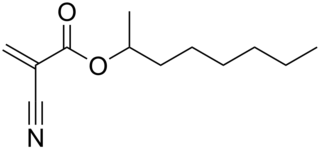
2-Octyl cyanoacrylate is a cyanoacrylate ester typically used as a wound closure adhesive. It is closely related to octyl cyanoacrylate. The use of 2-octyl cyanoacrylate was approved in 1998; offered as an alternative to stitches, sutures, and or adhesive strips.
Hydrophobic light-activated adhesive (HLAA) is a type of glue that sets in seconds, but only after exposure to ultraviolet light. One biocompatible, biodegradable HLAA is under consideration for use in human tissue repair as a replacement for sutures, staples and other approaches.
Postoperative wounds are those wounds acquired during surgical procedures. Postoperative wound healing occurs after surgery and normally follows distinct bodily reactions: the inflammatory response, the proliferation of cells and tissues that initiate healing, and the final remodeling. Postoperative wounds are different from other wounds in that they are anticipated and treatment is usually standardized depending on the type of surgery performed. Since the wounds are 'predicted' actions can be taken beforehand and after surgery that can reduce complications and promote healing.
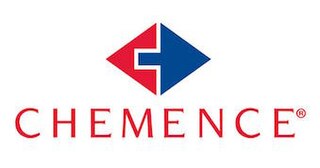
Chemence is a speciality chemical and medical device manufacturer which products include cyanoacrylate adhesives, anaerobic adhesives, impregnation sealants, adhesive activators, epoxy resins, UV adhesives, photopolymer resins, custom printer ink cartridges, Gas pipe sealants, and soak off nail polishes. Chemence is a supplier of photopolymer and commercial printers to the flexographic industry in the US and Europe, as well as the primary sealant supplier to British Gas, and a primary supplier of private-label adhesives to companies including Tesco, 3M, Bostik, and Bondo. The company's catalogue of patents includes processes, packaging devices, and chemical combinations.













